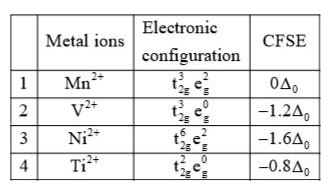A complex typically absorbs at around 600 n. it is allowed to react with ammonia to form a new compelx that should have absorption at:
800 nm
580 nm
620 nm
320 nm
The correct Answer is:B
To solve the problem, we need to analyze the absorption properties of the two complexes, (M(H₂O)₆)²⁺ and (M(NH₃)₆)²⁺, in terms of their ligand field strengths and how they affect the crystal field splitting energy.
1. Identify the Initial Complex and Its Absorption:
- The complex (M(H₂O)₆)²⁺ absorbs light at around 600 nm. This indicates the energy difference between the split d-orbitals (Δ) corresponds to this wavelength.
2. Understand Ligand Strength:
- Water (H₂O) is a weaker field ligand compared to ammonia (NH₃). The strength of a ligand affects the crystal field splitting energy (Δ). Stronger ligands cause greater splitting of the d-orbitals.
3. Reaction with Ammonia:
- When the complex reacts with ammonia, it forms a new complex (M(NH₃)₆)²⁺. Since ammonia is a stronger ligand than water, the crystal field splitting energy (Δ) will increase.
4. Effect on Absorption Wavelength:
- As the crystal field splitting energy increases, the wavelength of light absorbed will decrease. This is because the energy of the absorbed light (E = hc/λ) is directly related to the splitting energy (Δ). Therefore, a higher Δ corresponds to a lower λ.
5. Calculate the New Absorption Wavelength:
- Since the original complex absorbs at 600 nm and the new complex has a stronger ligand (NH₃), the absorption will shift to a shorter wavelength. The next nearest lower wavelength is 580 nm.
6. Conclusion:
- The new complex (M(NH₃)₆)²⁺ will absorb at approximately 580 nm.
Final Answer:
The absorption for the complex (M(NH₃)₆)²⁺ will be at 580 nm.
---
- The complex (M(H₂O)₆)²⁺ absorbs light at around 600 nm. This indicates the energy difference between the split d-orbitals (Δ) corresponds to this wavelength.
- Water (H₂O) is a weaker field ligand compared to ammonia (NH₃). The strength of a ligand affects the crystal field splitting energy (Δ). Stronger ligands cause greater splitting of the d-orbitals.
- When the complex reacts with ammonia, it forms a new complex (M(NH₃)₆)²⁺. Since ammonia is a stronger ligand than water, the crystal field splitting energy (Δ) will increase.
- As the crystal field splitting energy increases, the wavelength of light absorbed will decrease. This is because the energy of the absorbed light (E = hc/λ) is directly related to the splitting energy (Δ). Therefore, a higher Δ corresponds to a lower λ.
- Since the original complex absorbs at 600 nm and the new complex has a stronger ligand (NH₃), the absorption will shift to a shorter wavelength. The next nearest lower wavelength is 580 nm.
- The new complex (M(NH₃)₆)²⁺ will absorb at approximately 580 nm.
The absorption for the complex (M(NH₃)₆)²⁺ will be at 580 nm.
Topper's Solved these Questions
- CO-ORDINATION COMPOUNDSBook:VK JAISWAL ENGLISHChapter:CO-ORDINATION COMPOUNDSExercise:SUBJECTIVE PROBLEMS
Explore 42 Videos
- CHEMICAL BONDING (BASIC)Book:VK JAISWAL ENGLISHChapter:CHEMICAL BONDING (BASIC)Exercise:SUBJECTIVE PROBLEMS
Explore 54 Videos
- d-BLOCK ELEMENTSBook:VK JAISWAL ENGLISHChapter:d-BLOCK ELEMENTSExercise:ASSERTION-REASON TYPE QUESTIONS
Explore 32 Videos
Similar Questions
[Co(H2O)6]3+ complex is
View Solutionthe pair of metal ions that can give a spin - only magnetic moment of 3.9 BM for the complex [M(H2O)6]Cl2is
View SolutionB2H6 reacts withNH3to form
View SolutionB2H6 reacts with NH3 to form
View SolutionUnmatched characteristic of complex [PdCl2(H2O)2(NH3)2]2+ is:
View SolutionSelect incorrect match for [M(H2O)6]2+ complex.

View SolutionReaction of ammonia with diborane gives initially B2H62NH3 which can also be written as
View SolutionWhich of the following is true about the complex [PtCl2(H2O)(NH3)]?
View SolutionWhich of the following is true about the complex [PtCl2(H2O)(NH3)]?
View SolutionA: [Cr(H2O)6]3+ is Inner orbital complex.
R: H2O is strong ligand generally
View Solution